The City of Indianapolis has a brief, but rapidly expanding relationship with on-street bike lanes. From as little as a few total miles of bike lanes as recently as 2008 to over 100 miles in 2014. Through this process, the City has learned a great deal about the construction, maintenance and planning involved in creating a truly sustainable and connected system where users feel safe.
Recently, the City announced plans to rework some of the first bike lanes developed along East New York and East Michigan Street. Originally white painted lines adjacent to vehicle traffic lanes, these bike lanes have since filled with debris, become worn down and have been all but disregarded by daily traffic. People traveling by bike are often forced into the street or on the sidewalk and it is all too common to see people heading the wrong way in the bike lane to make a quick trip.
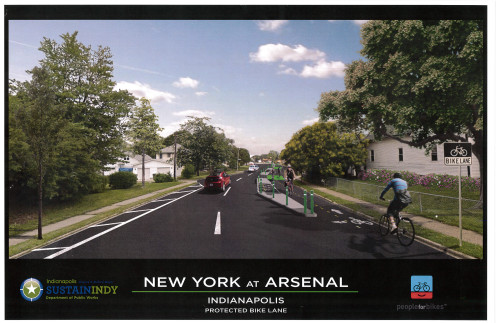 As part of a planned resurfacing project on New York and Michigan Streets, the associated bike lanes will receive a significant upgrade between the railroad tracks just east of I-65/70 and Rural Street. The entire stretch of bike lane through this section will become physically separated and protected from adjacent vehicle traffic by use of concrete medians, planters, tree lawns and bollards. Even more exciting, the stretch between Arsenal Avenue and Eastern Avenue on both streets will become a two-way cycle track, similar to Shelby Street in Fountain Square.
As part of a planned resurfacing project on New York and Michigan Streets, the associated bike lanes will receive a significant upgrade between the railroad tracks just east of I-65/70 and Rural Street. The entire stretch of bike lane through this section will become physically separated and protected from adjacent vehicle traffic by use of concrete medians, planters, tree lawns and bollards. Even more exciting, the stretch between Arsenal Avenue and Eastern Avenue on both streets will become a two-way cycle track, similar to Shelby Street in Fountain Square.
Users of these bike lanes and those that travel adjacent to them by car know that it is not uncommon to see a bike coming at you in the opposite direction. While much of this is education, enforcement and freewill, there is also a real life lesson learned that for short, neighborhood-based trips, people on bikes will take the quickest available option. The City has responded to this by offering the two-way option for a portion of this route. The obvious question becomes, “What happens when the user reaches the point where it converts back into a one-way bike lane?”
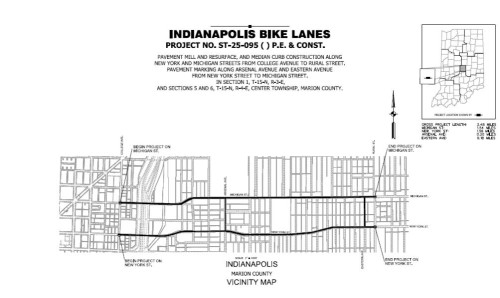 Planning documents and engineering drawings show the addition of a north-bound bike land along Arsenal Avenue as well as a sharrow system along Eastern Avenue. These two additions will work to filter two-way traffic back into the existing one-way pairs. Using lessons from the Shelby Street Cycle Track, as well as other national examples, the width of the lanes, curbs, tree lawns, planters and the construction technique for the bollards will allow for the cleaning of debris and clearing of snow as well as adequate protection for people traveling by bike. Curb cuts for drainage, cross traffic and
Planning documents and engineering drawings show the addition of a north-bound bike land along Arsenal Avenue as well as a sharrow system along Eastern Avenue. These two additions will work to filter two-way traffic back into the existing one-way pairs. Using lessons from the Shelby Street Cycle Track, as well as other national examples, the width of the lanes, curbs, tree lawns, planters and the construction technique for the bollards will allow for the cleaning of debris and clearing of snow as well as adequate protection for people traveling by bike. Curb cuts for drainage, cross traffic and 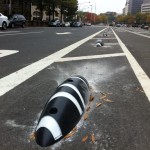 pedestrian crossings will generally make use of “armadillo humps” to continue the physical separation and notification to people traveling adjacent to the lanes in vehicles. One of the more exciting features of this project, not shown in these renderings, is the work that is being done with IndyGo. Bus stops along this stretch, typically found on sidewalks adjacent to the curb, will be moved to the edge of the protected bike lanes onto an eight-foot wide “platform” of sorts, connecting to the sidewalk with a cross walk and ramp. this will allow for buses to pick up and drop off riders without the often dangerous and difficult task of merging across a bike lane and then having to merge back into vehicle traffic.
pedestrian crossings will generally make use of “armadillo humps” to continue the physical separation and notification to people traveling adjacent to the lanes in vehicles. One of the more exciting features of this project, not shown in these renderings, is the work that is being done with IndyGo. Bus stops along this stretch, typically found on sidewalks adjacent to the curb, will be moved to the edge of the protected bike lanes onto an eight-foot wide “platform” of sorts, connecting to the sidewalk with a cross walk and ramp. this will allow for buses to pick up and drop off riders without the often dangerous and difficult task of merging across a bike lane and then having to merge back into vehicle traffic.
These dramatic improvements are generally possible due to the wide right-of-way along this stretch. Most of this stretch includes two parking lanes and a minimum of two travel lanes. This project will remove one of the parking lanes, often unused, to provide a wide and safe facility for people traveling by bike while maintaining vehicle traffic flow. The addition of a narrower vehicle travel area, tree lawns, planters and curbs will serve as traffic calming elements and will create a much needed separation of pedestrians from vehicle travel lanes. These improvements may not be perfect and I know people will always look for more to be done, but it is clear that the City is moving in the right direction with this investment and I think we will all agree that what is proposed here, will provide a much more improved experience and level of safety for users.
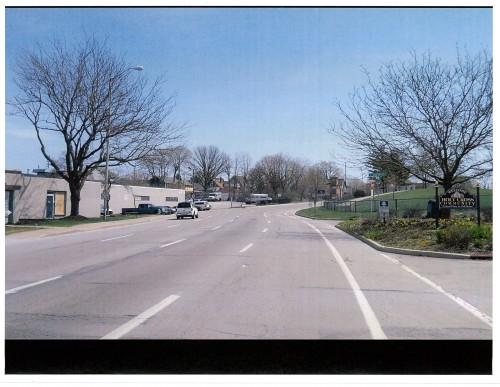
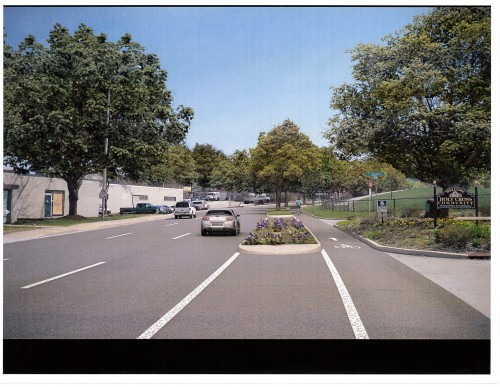
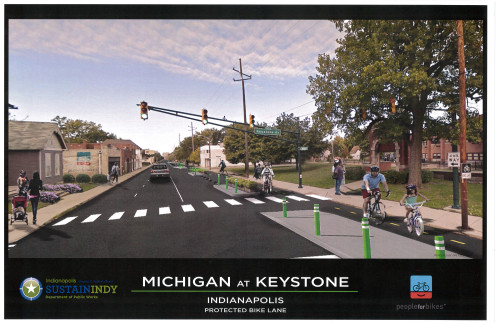
Just a few questions on this:
1. Why doesn’t the city use the reflective lane paint that every other city uses? You know, the kind that motorists can actually see?
2. Why aren’t there any storm drains anywhere, as to prevent massive puddling near the curb when it drizzles for a few minutes?
3. Why are these new bike lanes being installed on the east side of I-65/70? Who in their right mind would ride that stretch of road without the protection of SWAT-rated bulletproof glass and/or Popemobile security?
4. Why are my taxes being spent to improve the ghetto, where no taxes are paid?
5. Where is the fife?
6. Give me the fife.
To answer your reasonable questions:
1. All upgrades and reworking of bike lanes, as well as street lane markings will make use of thermoplast instead of paint. This will be a dramatic improvement.
2. You would have to check with DPW on this. It obviously depends on the rainfall rate and the ability of adjacent property owners to clear the drains of debris.
… and I’ll go ahead and answer your unreasonable questions, Langdon:
3. As someone who lives in the area you describe, I can attest to the fact that we are, in fact, an avid bike-riding people. Two-way bike lanes along Michigan and New York, both one-way streets, will be heavily utilized.
4. We are a tax-paying people, as well.
5-6.) Your mother has the fife. Just saw her with it yesterday. Kinda hard to miss, actually.
This comment is out of bounds on this website, but I will leave it up as there are some decent replies to it.
My brother and his family are looking at moving to Irvington and my main qualm was that there was no good bike route out there. The terrible bike lanes on New York and Michigan were not acceptable for hauling kids in a trailer. These new lanes will be terrific and I can’t wait to use them.
And to Langdon, thanks for trolling, but anyone who’s been to the near eastside recently, knows you have no clue what you are talking about.
Don’t forget the Pleasant Run Trail.
It still has a couple of connectivity problems, but they have been dramatically reduced. The Cultural Trail will take you from anywhere downtown to Fountain Square. The Shelby Street bike track will take you from Fountain Square to the Pleasant Run Trail. One of the major missing teeth in the PRT has been resolved by the recently constructed Keystone Avenue bike track. You still have to ride on the sidewalk for a few blocks on English Avenue, and you’ll have to duck when you go under the railroad viaduct near Irvington. And the crossing of Washington Street is far from ideal. But it’s certainly viable for a family bike ride.
I live in the area, and this improvement will directly impact my desire to ride my bike to my downtown job. When I do ride (which is currently not very often) I use 10th Street and go down the Cultural Trail (somewhat out of my way) because I think the Michigan and New York bike lanes are not safe. But I will now use my bike much more often.
In addition, I’ve purchased my second house on the near-eastside, and my property tax assessment increased by $100,000, so yes, we do pay taxes.
One suggestion: with these planned upgrades to Michigan and New York, perhaps this is the perfect time to turn these back into two-way streets. Is there any appetite/possibility for such a change?
This is good news. As a daily Irvington to downtown bike commuter, I don’t relate to the hysteria about safety. There are good and friendly people along the way. I haven’t experienced a lick of a problem in the ten or so years I’ve been at it. The existing bike lanes have not been well maintained, I assume in favor of using scarce dollars to push the bike lane mileage up. This is shortsighted. At least the city improved the insane railroad underpass east of Lasalle. I hope the city will pay attention to maintenance of the new cycle tracks. If they become unridable, moving into the street will be tougher. This improvement will help with the existing challenge of playing hop scotch with IndyGo #3 bus.
Michigan and New York should both be two way streets. Traffic volume does not warrant one ways. It would enhance the livability of the environment. They could also save money by two-way laning the cycle track on just one of the two streets and use the savings to run the cycle track out to Irvington.
I don’t know much about fifes.
Lundy, I’m with you (mostly) on the danger issue. I’m not a daily bike commuter, but I would conservatively estimate that I do so about 50 times a year from Irvington and have done so since 2007 (a year or two before the lanes were painted). I can count on one hand the number of close calls I have had, and none of them relate particularly to the configuration of the lanes. I share the frustration of those who note how poorly the lanes have been maintained. They were applied with cheap paint, the lines are rarely and sloppily repainted, and the arrows and bicycle icons have never been repainted.
I agree with the critics above that I wouldn’t be comfortable taking young kids or a tow-behind trailer with kids on those lanes. But I can’t identify with being afraid to commute on those lanes, and particularly not with viewing riding my bike on 10th Street as a preferable alternative.
This is off the subject,but if someone knows how to post this to ssc please post if able, That being that there is at least 60 or more developments planed or under construction in or around downtown indy,but yet the indy thread is always full of spoken word/talk as opposed to 99% of other cities and states check for yourselves Fl.,ohio,cali,tex,minnap,milwalk,ws.etc.why is this,And heck even the second largest city loves showing off new developments,whoes next Gary,lol It really makes indy look weared even being that other cities have seperate discusion boards and indy dosent for a city its size. So if someone here could please post this to ssc/indy development i would appreciate it thanks ps. Tony Jackson.
losts of great street scapeing and beautification going on around indy,also wonder if theyre going to install these lanes in or around the new msa/360 market east district.
Excited to hear about the bus “platforms” being added to this project. Playing peekaboo with a bus is just irritating. I’ve experienced this design in Europe and it works.
Now if we can just maintain this after it’s built. The Shelby street cycle track bollards look terrible.
The bollards that will be used for these lanes will not be concrete and steel posts. These bollards will be affixed to the curb, but will be “bendable” upon heavy contact. They can also simply be removed and replaced without major construction work. Additionally, all lanes will now be wide enough to allow for a small plow and street sweeper to pass through them for cleaning.
Will they have a curb for sure? Hopefully they will or else they will end up looking like those at 96th and Meridian where half are knocked over at all times. Not exactly a comforting site for someone on a bike but something that will happen if the physical barrier does minimal damage to a car.
Yes, there will be a curb. In locations with a planted median, the median will be within a raised bed. In locations that are just concrete separation, there will still be a raised concrete curb to provide the median.
Does anyone know when the Pennsylvania Street bike lane (Washington to St Clair) is supposed to begin work?
I hadn’t heard about this. Do you have any details? Protected? Part of a two way conversion, lol!?!
Me neither. This makes a lot of sense…that road is underutilized and has at least 2 lanes to spare.
I haven’t heard a lot of follow up on that project. I did see at one point they were going to install another dulling pair of bike lanes on Penn and Delaware. They just repaved Penn, but it doesn’t look like they painted the lanes.
If the pair (similar to Illinois and Capitol) is true, that is really disappointing and shows that now lessons have been learned. Those lanes are underutilized because it is about the most frightening bike-specific place in the city to ride. Car doors on one side, 50mph traffic on the other.
Last I heard (earlier in March, I believe) they were planning to paint the new bicycle lane onto Pennsylvania once it got warm enough for the paint to stick…and I’m pretty sure temp shouldn’t be an issue anymore. They were going to do the bike lane on the far right, then a lane of parallel parking to protect the bikers against traffic. Also, I think the Delaware bike lane isn’t scheduled until next year, possibly to coincide with a separate paving project?
I’d be totally on board with lanes next to the curb if there is a curb on both sides. Otherwise, cars will definitely be parking in it and it will be debris-filled.
Ahow628 – I think you are going to be out of luck on curbs on both sides of the Pennsylvania bike lanes if I understand the project correctly. However, I don’t think it’s as big of an issue as you might think. Mass Ave already has parallel parking next to the Cultural Trail in some sections (across the street from IPS bus parking) and that doesn’t seem to be an issue. As long as they put a 3′ painted gap (which is best practice to prevent ‘dooring’) and add parking meters that should prevent cars parking in the bike lane. Parking tickets for offenders would deter the practice too
Sorry, “no lessons have been learned.”
I am really glad this is finally trickling over to the near-eastside. I have traveled the current lanes with and with out my child in tow. I must be in the minority, but I have never (during the day) felt the slightest bit endangered. Riding at night by myself with lights that is a different story.
This is a really good chance to re-enliven these commercial areas and build new mixed used buildings. Study after study has shown that these kind of bike lanes create good commercial areas.
Lastly the traffic lanes are being shrunk down to residential sized lanes from there current highway sized lanes. This will slow traffic down naturally which will make it safer for pedestrians and those cycling.
I understand the desire to make the city more attractive and user friendly for bikers pededstiens and motorists. However, we need to look at a couple things first before making dramatic desisions that cost taxpayers large sums of dollars and affect everyone around. 1st. how many bike riders vs. motorists are there whate is the ratio and persentages? 2nd, There are currently X lanes to accomodate traffic which were built based on that aamount of traffic, but now with the growth of the city and extensive expansion in housing the traffic would and will be more not less. How can that be accomodated if lanes are eliminated? Thus potentially causing even more safety issues as motorists jocky for position. 3rd. those roadways were constructed to not only handle the traffic volume but the weight of that volume, being built very thick to handle the tonnage, of whch we paid for. Now those rodeways are being reused for cyclists and or nothing at all. Cerainly don’t need to be that thick. Lastly, curbs and sidewalks already exist. why cant they just be expanded a couple or three feet to accomoddate the cyclists instead of depleting an existing resource which if not needed today will most definietly be needed in the future. The costs would more than likely be the same if not less and accomodates traffic both ways as the sidewalks do now. Otherwise, it will have to be redon again down the road as the city grows, at an even higher cost. The bike lanes in the road just don’t seem logical when safer, more affordable, cleaner, more attracive alternatives are available. please answer best you can for the populous.
Jack,
Thanks for your interest and response to the article. I will do my best to reply point-by-point, but I will note that some aspects of transportation come down to ideology, which may always differ.
1. It is very clear that the number of people traveling by automobile today is significantly higher than those traveling by bike. While this margin is still significantly weighted towards automobiles, the percentage of people using the bike to travel is increasing, while automobile mileage and ownership is decreasing. To this point, I would submit that, prior to cars, the reliance on horses and public transit far outweighed those that traveled by car in their onset. As the City developed infrastructure, the car became the catered form of transportation. This was the result of marketing, huge investment by car companies to push this mode of transportation and large lobbying efforts to politicians.
2. The proposal for NY/Michigan Street protected lanes will not remove any current travel lanes for automobiles. If you travel along these routes, you will notice that there are only two consistent travel lanes, the other two are parking lanes, or occasional turn lanes. Therefor, the impact of this project to existing travel lanes will be minimal. In fact, people traveling by car will likely have an easier time, now that there are less options to weave in and out of lanes only to find your lane running out as a turn lane. I would like to note that these roads are from the very early stages of development in the City, when the automobile was not the primary transportation. Both streets were actually two-way streets. If you notice the significant curve at Michigan Street and Highland, that originally came to a 3-way intersection, then motorists had to jog to continue either direction on Michigan. To say that these streets were intended to be one-way expressways would be incorrect.
3. the thickness of the street is of no consequence. This project is not rebuilding the lanes, simply working with resurfacing. Related to #2, it is clear that the amount of infrastructure the City developed is now exceeding the number of users. This proposed modification will not alter existing automobile flow, but will make better use of existing space. People will now have an option to travel other than by car. The good news is, the City currently has to deal with 4-5 lanes when resurfacing or repairing due to vehicle weight. After this modification, the two-3 travel/turning lanes can be focused on for maintenance while the bike lanes will be very low maintenance.
4. Typically, the outside edge of the sidewalk represents the extent of public right-of-way. Therefor, any additional land would have to be acquired from private property owners, a very expensive, difficult and time-consuming process. Sidewalks are also typically constructed at edge of pavement through these corridors. If we expand them into the street, we are essentially doing what has been proposed, but at significantly more cost. As I noted in #1, the usage of automobiles and vehicle miles traveled is declining, not rising. Your assertion that automobile demand on roadways will grow may not be accurate. It has been shown that people traveling by bike have increased, but we lack safe, dedicated ways for people to do this.
Like I said, some things are simply ideology and there will always be differing opinions. What is clear is that local residents, those that pay taxes to this city, are demanding alternative, safe transit options, including the bike. What is unfortunate is that, as the City declined, people took advantage of subsidized housing in outer Marion County and further east. This creates significant demand and wear on these local streets and residents have to suffer. If the ability to travel, unrestricted by car is what someone is looking for, they can live at an interstate exit and only travel along interstates, a space reserved exclusively for automobiles. Streets were not intended to be dedicated space for automobiles, but have been engineered that way. It is exciting to be living in a city that is finally encouraging safer, cheaper, healthier options for local residents.
Now all that we have to do is find a way to get drivers (including municipal employees and law enforcement officers!) to treat both stop signs and no turn on red signs as more than suggestions.
I should not have to ride with a video camera on my helmet in order to prove that a driver cut across my path or failed to yield to me.
This is an old post obviously, but I recently looked at property on East Michigan St with very limited parking because of the wide 2-way bike lane that eliminates the majority of street parking in the area.
I’m thoroughly confused as to why Indianapolis would eliminate valuable parking space that helps residents and particularly businesses, in lieu of a very small percentage of local people who would bike these same areas–particularly when biking is only practical in Indiana for a few months out of the year.
These massive 2-way bike lanes (with medians that take up additional street space) will waste public space for the majority of the year as the bike lanes sit idle. Meanwhile, parking is needed year-round. And I am all for green commuting options, but biking is not the answer and never will be en masses in any state.
Weather, distance, time, age, dress, cargo, etc, will always favor a powered vehicle over a single person, self-powered, un-enclosed, non-cargo carrying bike.
Thinking that bikes are the long term answer and prioritizing them above vehicles is short sighted— Electric or hydrogen vehicles (or eventually drones) are the answer– and Indy has removed a massive amount of public roadway infrastructure that will now sit idle most of the year that would allow needed parking space now and for future vehicle types. Foolish, in my opinion, unless someone can explain to me.
For now, I foresee millions being spent in the future to convert these bike lanes back to parking or traffic lanes. The number of cars will only continue to increase, particularly as we ultimately see self-driving vehicles that put more people more often (ie elderly, disabled, children) on the road that were not previously.
The particular area I looked at on Michigan St has several houses and a business that could effectively no longer have guests or customers visit—unless they now parked a block or more away.
If these bike lanes are for work commuters, tell me what percentage of downtown workers bike daily (especially in cold months, and especially those more professionally dressed), particularly as more people work remotely?
And as has been most of my life, sidewalks seemed to work just fine for bikes for leisure. I rode all around as a kid, college student, and young adult on sidewalks—although the older I got and with a family or for store trips, biking is not a practical option, and I never lived close enough to work to ever bike there.
When I did bike on sidewalks (for leisure or maybe to a restaurant), it was not high speed, but it worked just fine— more often I just walked. That’s the green solution that never goes out of style.
For the longer distances we all travel these days, we need our enclosed vehicles that can transport several people, groceries, etc. And for that, we need places to park our vehicles. Bikes can manage otherwise as they always have. Our roads were built for vehicles, not bicycles.
I do see the need to share the road, but not half of it that can no longer be shared with cars as well. I can predict the Indiana bike traffic on Michigan Avenue in January: 2. Car traffic, however, will remain amazingly consistent year round.
If anything, stick to smaller bike lanes—or one-way bike lanes, even. Dont eliminate an entire traffic plus a parking lane for a treed median and 2 way bike traffic.